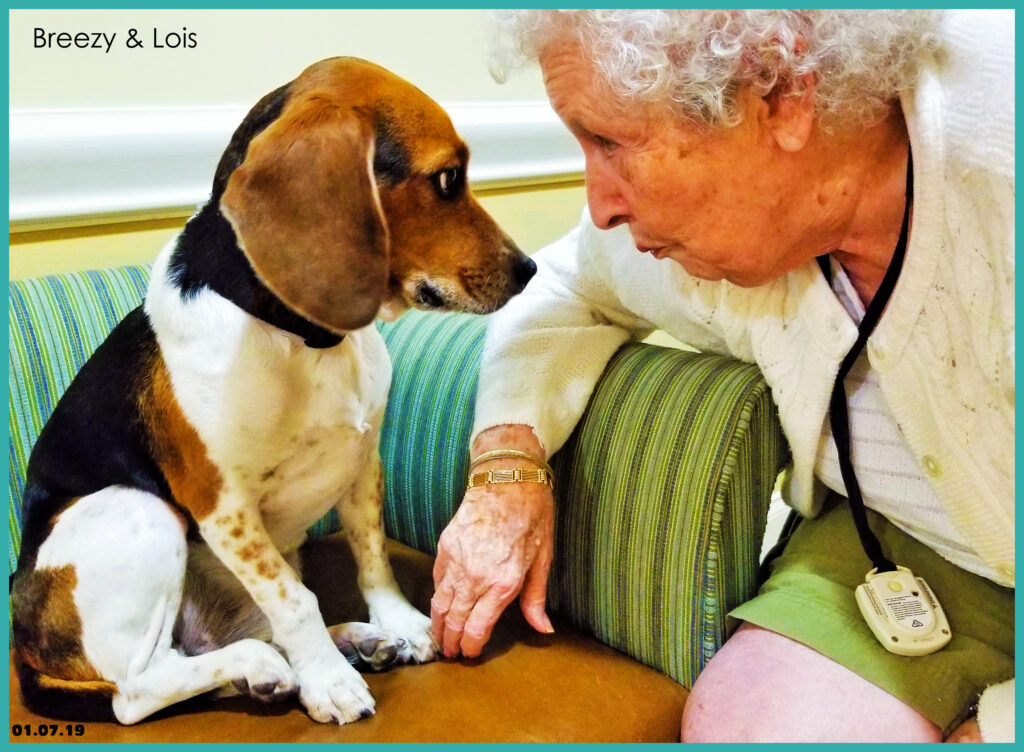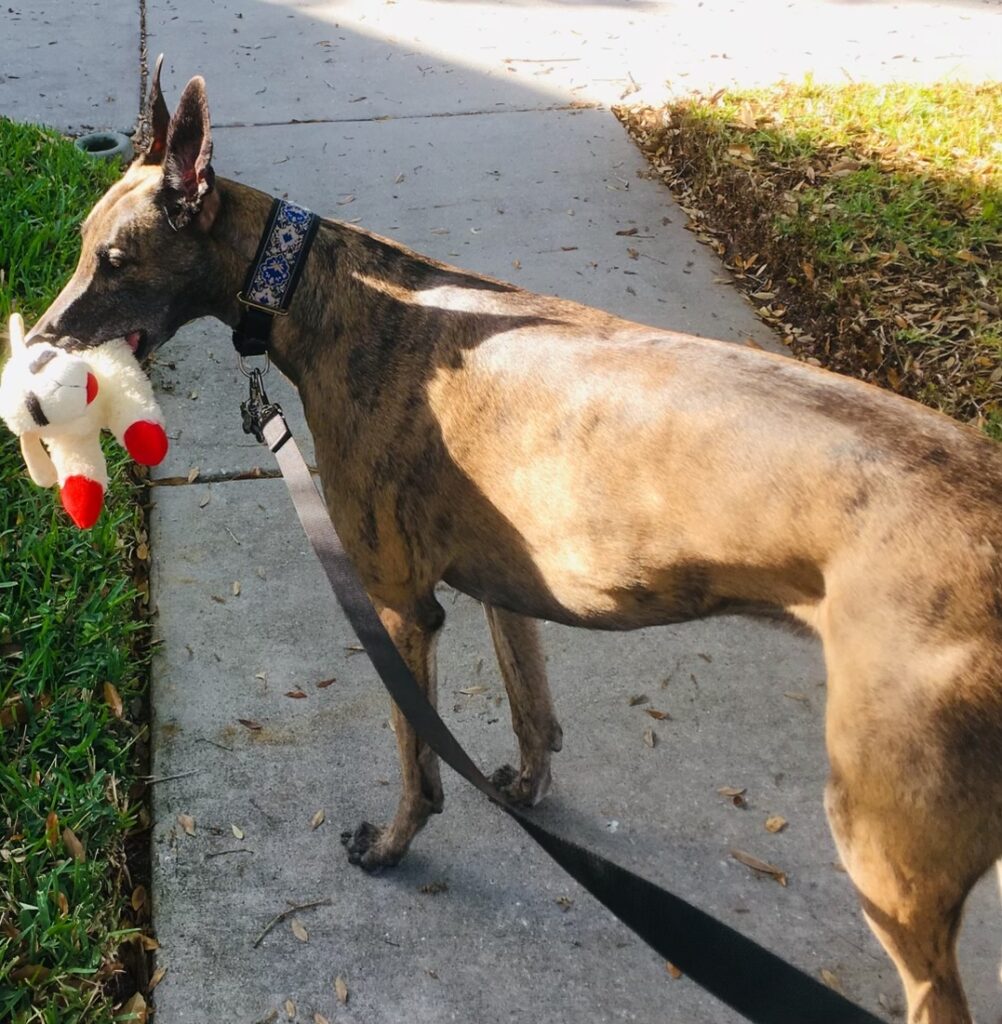
By Lynn Gonzalez
You probably know Mandolin Reserve as a relatively small community with residents of all ages and occupations.
What you may not know is that three of its four-legged residents are unlikely heroes who came from the humblest of beginnings. Breezy, Everest and Jax were rescued by three different families who transformed them into dedicated therapy dogs. The trio have spent endless hours providing love and companionship to children, the elderly, the infirm and others in need. These are their stories.
Breezy
The old adage says that cats have nine lives, but Breezy the beagle may prove that the saying applies to dogs, too. Owner Neil Presant adopted Breezy after the dog was found malnourished and wandering near a busy roadside in New Iberia, Louisiana. A passerby rescued the plucky pup, then unknowingly delivered him to a high kill shelter where he was scheduled to be euthanized.
Luckily for Breezy, an employee at the shelter called a local beagle lover who agreed to foster him until something could be done to save his life. The woman connected with the Southeast Beagle Rescue Group, which transported him to a foster home in Tampa. It was there that Mandolin Reserve resident Presant first met him in May of 2014 and immediately fell in love.
The following year, Breezy and Presant were at a park in the Safety Harbor area when they came upon an event designed for dogs and their owners. Paws for Friendship Inc., an international pet therapy volunteer organization, had a booth at the event. The president of the organization at the time told Presant that she had a special feeling about Breezy. She asked Presant a question that would change both of their lives: Have you ever thought about sharing your dog with others?
“I’d never thought about it,” said Presant. “How would I know if Breezy could do it? And she said, ‘Trust me, he can do it. We’re here to find new dogs to join our volunteer organization. I’ve been watching you since you got here. Your dog is the most social dog in the park.’”
Soon after that initial meeting, Presant brought Breezy to shadow two therapy dogs at an assisted living facility (ALF) in Clearwater. He said that when his beagle entered the facility, it was like somebody flipped a switch that turned his barking, excitable dog into a calm, engaging therapy dog. Breezy, it turned out, was a natural.

A therapy dog is not the same thing as a service dog. Service dogs have to endure a tremendous amount of training and testing, while therapy dogs simply need to have a loving disposition, explained Presant. They should be well socialized pets who get along well with people and other pets, and thrive in a variety of social situations. Presant still finds Breezy’s transformation remarkable.
“It’s like he knew what to do, like he’d done it before,” mused Presant. “I always tell people that we didn’t go looking for pet therapy. It found us. It’s been amazing. We went from having no thoughts of ever doing anything like this, and, as of today, we’ve done more than 700 visits. There was never one that was routine.”
Over the next five years, Breezy would become one of the most highly decorated pet therapy dogs in America. He has visited residents of nursing homes and ALFs; students at Citrus Park Elementary School; young people at Joshua House, a safe haven in Lutz for abused, abandoned and neglected children and teens; and a variety of other people in need.
Presant’s mother struggled with dementia and lived in an ALF before she died, so memory care units hold a special place in his heart. But that is just one small part of the impact that this special beagle has made. Breezy has comforted those in hospice, encouraged students to read, and brought smiles to the faces of elderly nursing home residents who hadn’t smiled in months.
Paws for Friendship requires volunteers to participate in pet therapy at least once a month. Presant said that although he and Breezy started out monthly, they quickly transitioned to making weekly visits. Before he knew it, they were making therapy visits full time.
“Pet therapy is basically a pet bringing a smile to someone who needed it. Sometimes to be able to pet a dog is a magical thing,” said Presant. “I always tell people that the people we visit get a lot out of it. Breezy gets a lot out of it. Honestly, though, I think I get the best of all worlds. I have the best seat in the house and I’m incredibly blessed to watch it all happen.”
The American Kennel Club (AKC) has a program that awards official titles to therapy dogs who have worked to improve the lives of those they have visited. To earn the AKC Therapy Dog Distinguished (THDD), a dog must have completed 400 visits. Breezy was on the verge of earning this most prestigious of titles when disaster happened.
Breezy had achieved the remarkable milestone of 399 visits when he was stung by a wasp and went into acute anaphylactic shock. Presant rushed the nearly lifeless beagle to a nearby animal hospital. If it weren’t for the grace of God and an amazing veterinarian, Breezy wouldn’t be here today, according to Presant. Five days after Breezy’s near-death incident, he finally earned the prestigious THDD.
Unfortunately, that would not be the last of Breezy’s brushes with death. In summer of 2021, Presant’s beloved beagle was diagnosed with lymphoma. After a long schedule of chemotherapy, he went into remission this past March. But at the end of July, he came out of remission and is currently fighting for his life. Because his immune system is suppressed, he’s not allowed to be around other dogs or people, and his therapy career is temporarily on hold.
“He’s already exceeded the life expectancy of a dog with lymphoma. We’re hoping for a second remission. The outlook is not good, but we take every day as it comes,” said Presant. “God willing, if he goes into second remission, we’ll return to pet therapy. That’s his legacy. I know that’s why he was put on this earth. If I can get one person to rescue a dog instead of buying a dog, or one dog to become a therapy pet, then Breezy’s legacy goes on.”
Everest
Fred Freshcorn has owned and fostered greyhounds for 21 years, and his dogs have worked as therapy pets since 2005. At 86 years old, the Mandolin Reserve resident has experienced a lot. Something about his seven-year-old greyhound, Everest, stands out.
“He’s probably a little bit more outgoing [than my other dogs],” said Freshcorn. “He loves people and has no qualms going up to somebody and leaning against them. He’s a prize, and probably my best one.”
Freshcorn adopted Everest from the greyhound racetrack here in Tampa, which is where he has always adopted his dogs. After certifying some of his first greyhounds as therapy pets, he opted to continue doing so with subsequent dogs.
Everest was certified through Project PUP, which stands for Pets Uplifting People, a nonprofit organization serving Hillsborough, Pinellas and Pasco counties. PUP volunteers screen pets to ensure they have the appropriate temperament to visit hospitals, nursing homes, rehab centers and ALFs.
To be a therapy dog, they don’t have to know certain commands, explained Freshcorn. They do, however, have to be good natured and easily acclimate to strangers. Freshcorn and Everest primarily visit Moffitt Cancer Center and Mease Countryside Hospital. The patients aren’t the only ones who benefit from visiting with Everest, according to Freshcorn.
“Anybody that wants to see him can see him,” he said. “We don’t differentiate if they’re a patient or staff member or somebody who’s accompanying a patient. We could be in contact with more than a hundred people at Moffitt [during a visit].”
Patients pet Everest and let him lean against their legs, which most of them really enjoy. Although Freshcorn and Everest weren’t allowed to continue their therapy visits during Covid, they spent four and a half years visiting both facilities weekly prior to the pandemic. Freshcorn said that he and Everest have logged 185 therapy hours at Mease, and more than 250 at Moffitt.
Freshcorn said that he’s met more nice people than he can count through his work with Everest. He’s originally from Pennsylvania, yet once encountered a high school classmate while doing a therapy visit. Freshcorn keeps busy caring for his wife, but plans to continue working with Everest as long as he is able.
“He touches the lives of many people and creates smiles. We think we’ve served a purpose,” said Freshcorn. “There are very few people who don’t like dogs. The staff get to know him when he’s working all the time because he’s good therapy for them, too.”
Jax
Larry Ramey adopted Jax five years ago when the mixed breed puppy was just eight weeks old. The Mandolin Reserve resident and his wife had been thinking about adopting a puppy when a pregnant dog showed up at their local rescue, and they decided they wanted one of her litter. The puppy was part Great Dane, part Labrador retriever and part Staffordshire terrier.
They were living in Cincinnati, Ohio, at the time and owned a CrossFit gym. Right after they adopted Jax, they took the puppy to their gym with them. Ramey and his wife immediately knew there was something special about their dog. While most puppies would be excitable and uncontrollable in such a dynamic environment, Jax was calm, cool and collected.

Ramey had some experience training animals and started working with Jax, who took to it immediately. A neighbor and friend of his asked whether Ramey had ever considered training Jax to be a therapy dog. Ramey was intrigued, and enrolled him in a course at Off Leash K9 Training in Cincinnati that prepared Jax for the certification process. Jax passed his certification with flying colors when he was just under one year old, and was ready to begin his new career. After getting Jax certified, Ramey worked with an organization called Therapy Pets Unlimited that provided him with a list of organizations that were seeking interactions with therapy dogs. Initially, Ramey and Jax visited a variety of different types of organizations, from nursing homes to children’s hospitals and homeless shelters. Ramey soon came to learn that Jax had a special affinity for veterans.
“Jax just seemed to enjoy the veterans’ homeless shelter more than the other places. He was on cloud nine when he was with them,” said Ramey. “So, we naturally ended up going to the veterans’ organizations more frequently.”
Although Ramey never formally tracked Jax’s hours, the pair spent about four hours each week at the veterans’ homeless shelter for three years. Combined with their visits to other facilities, Ramey estimates that Jax spent about 1,000 hours in a three-year period helping those most in need.
“The base of it is to create comfort. He would walk up to someone and they would pet him and it calms people,” explained Ramey. “He recognizes anxiety. When we would go to the veterans’ shelter, he would find the person sitting in a corner not paying attention to him. He would see if he could get any type of attention from the people who weren’t necessarily looking for it. People who were just kind of existing.”
Jax, at 140 pounds, may not be a traditional therapy dog, but he has always had the demeanor and patience needed to serve in the role. Ramey explained that it was interesting to observe Jax in different therapy environments because he was always able to adapt himself to what clients needed. He moved gently and slowly in nursing homes, but was a bit more energetic with veterans, for example.
“He’s just a big sweetheart,” Ramey said. “He’s patient and lets people love on him and he reciprocates that love. He’ll sit [with clients] as long as you let him. It’s harder to get him out of places than to get him in.”
In May, Ramey and his family relocated to Tampa to care for his in-laws. Between work and family commitments, he hasn’t yet had an opportunity to introduce Jax to the therapy dog life in Florida. He’s talked to Presant about some of the possibilities, and hopes that he and Jax can return to the important work they were doing while in Cincinnati. Ramey has learned a lot from their therapy adventures together and misses the connections they made while seeing clients.
“I think it’s probably a cliché, but everyone needs and deserves love. With therapy dogs, it’s within them. It’s not something they can fake,” Ramey explained. “That genuine connection that I see him having with each person… I wish people could do that. Animals have that innate desire to love, and it doesn’t matter what they get back.”
Ramey shared a story about a Vietnam vet who had been living at the homeless shelter for six years. No one ever spoke to him, and he had a reputation for being an absolute loner. Ramey’s instinct was to leave the man alone, but Jax had other ideas. One day when they were visiting, Jax walked right into the man’s tent. Ramey slowly followed, unsure of what he would find. What he saw amazed him.
“Jax’s head was in the man’s lap,” recalled Ramey. “He didn’t say a single word to me, but talked to Jax for 30 to 45 minutes. He just chatted with him, and it lit up his day. That gentleman still never spoke to anyone. He pulled away from everybody. But somehow Jax got through to him.”